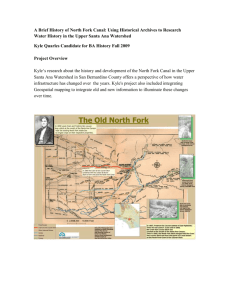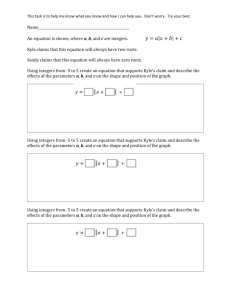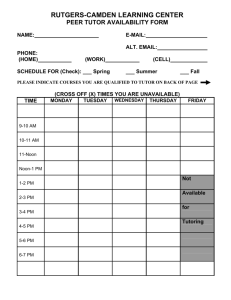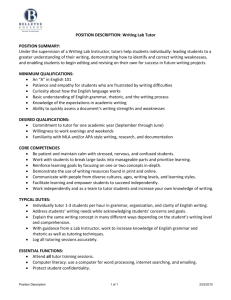Tutor/Instructor Symbiosis: Professionalization and Growth Through
advertisement
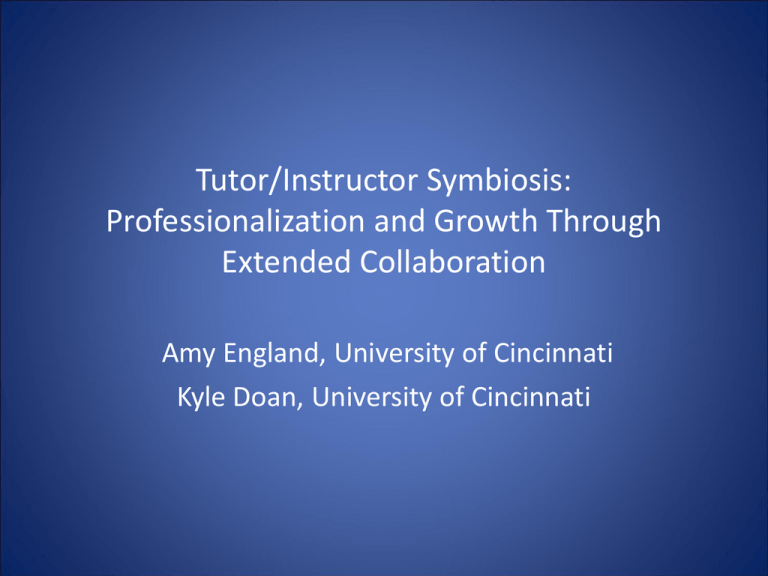
Tutor/Instructor Symbiosis: Professionalization and Growth Through Extended Collaboration Amy England, University of Cincinnati Kyle Doan, University of Cincinnati Overview • • • • Summary of Comp 101B Planning Implementation Reflections Summary of Comp 101B • • • • • Extended class time Guaranteed computer lab time Tutors in the classroom two hours a week Course cap at 15 students Nearly 100% full-time faculty instructors Pre-Project Expectations • Enhancement of active learning environment for at-risk students • More individualized attention from two experts with different styles, experience, and expertise Planning • Project approval process – Authorization from Writing Center Coordinator – Authorization of additional funding • Reflection on previous classes • Finding and selecting articles • Designing activities Planning (cont.) • Scheduling – In-class tutor participation – Out-of-class tutor involvement • Tutor introduction to the role of “instructor” – New terminology – New roles and responsibilities – Tutor acclimation to pedagogies and theories • Journal prompts and readings Implementation • • • • • Weekly lesson plans Pre-class communication Shared instructional duties and authority Guided, collaborative design of class activities Allocated time for tutor reflection and observation • Post-class reflection and discussion Team-Teaching Assessment • Team assessment of student essays and revisions • Team assessment of process work • Daily team assessment of class activities and student progress Essays and Revisions • Kyle’s assessment curve – Essay 1 – Amy reads and discusses her assessment with Kyle. – Essay 2 – Kyle adopts Amy’s assessment system. – Essay 3 – Kyle uses student essays to develop his own assessment system. Process Work • Reading responses – Periodically shared reading responses • Class discussions – Reflective assessment and revision based on conversational content • Workshops – Reflective assessment and revision based on student progress Daily Assessment • Assessment of class activities and student progress • “Observer” critiques “instructor” pedagogy • Closer monitoring of individual students’ progress • Troubleshooting potential problems Surprises for Amy • Compensation for extracurricular tutor activities was more complicated than we thought. • Instructor’s diffusion of authority was more difficult for her than anticipated. • Temporary disruption of established patterns in the classroom • Timing was off; first few classes went too short or too long • Conscious effort to include Kyle early on • Lesson plans and reflections written for a second person – required more effort and time than anticipated. Surprises for Kyle • Amount of time required for proper class design and pre-class preparation • How well one-on-one tutoring translates into the instructor’s role • The necessity of a backup plan • Diverging pedagogies and theories Unexpected Bonuses • Constant collaboration revitalized Amy’s teaching and made Kyle want to continue and expand his professional development. • Collaboration enhanced reflection. • Improved response to individual students’ needs and learning styles. What We Would Do Differently • • • • Arrange for more meeting time Arrange for funding before the project started Ask for more release time Develop more lesson plans in advance

